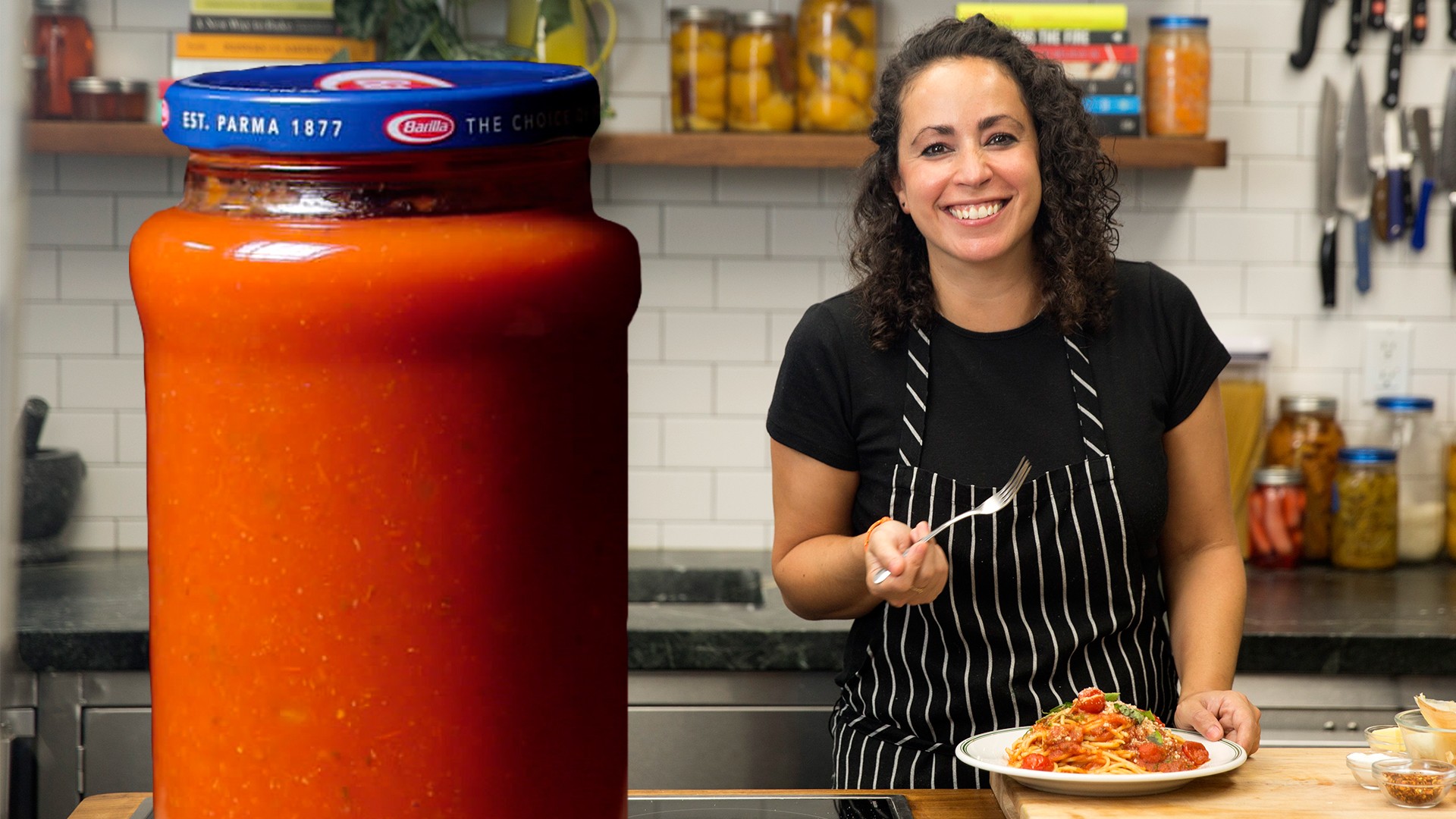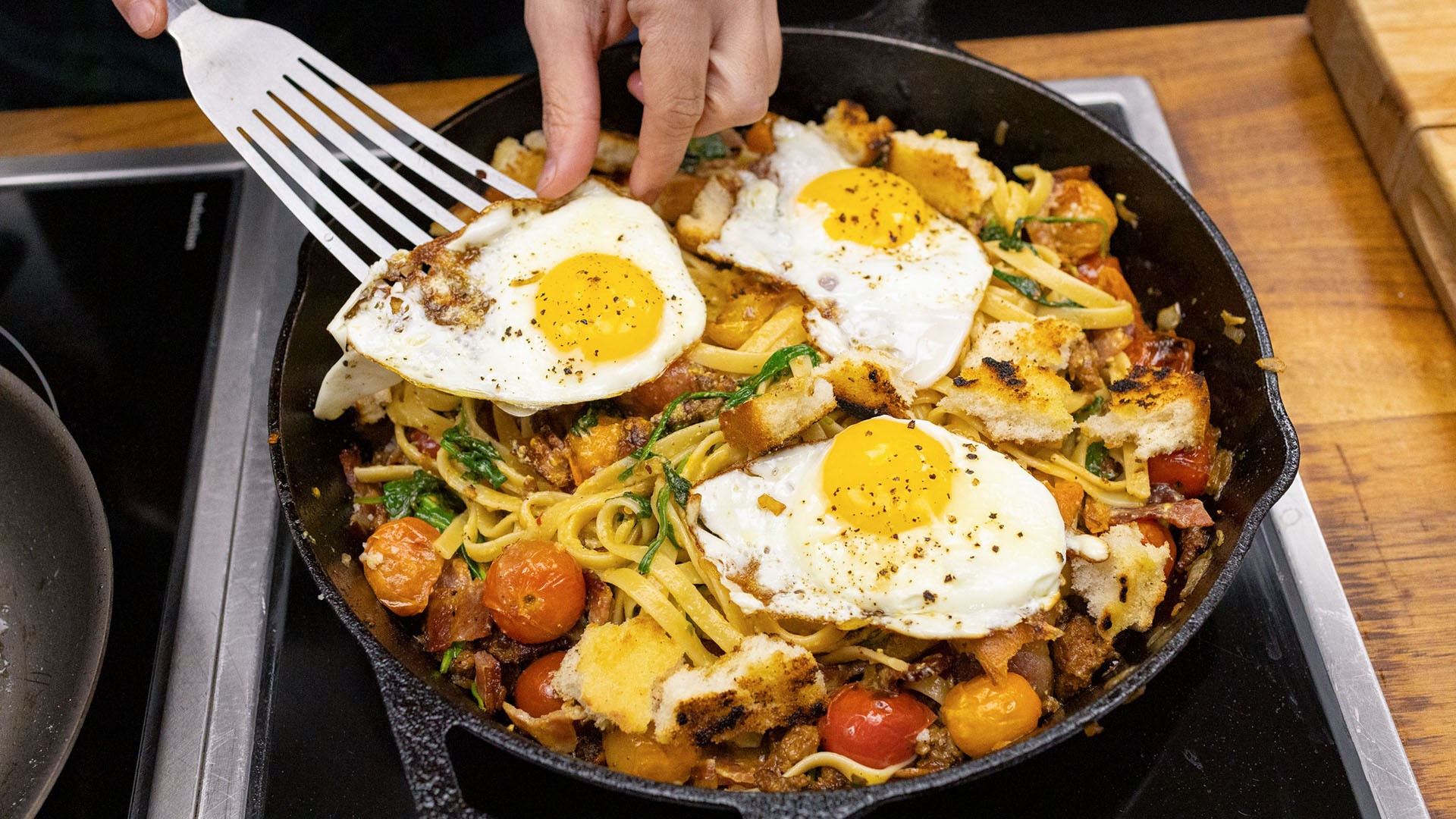With everyone spending more time at home these days, we’re all finding ourselves in the kitchen a lot more, whether we want to be or not. And man, is it a scary world to navigate if you’ve never really had to cook before. That's how you end up with things like "Babybel and Quorn ham 'salad.'"First of all, relax: You can feed yourself. That's what recipes (of which we have many) are for—they're instructions! We test our recipes to make sure they don’t fail you, and if you have the ingredients, the equipment, and the good sense to read the recipe a few times before getting started, you should be good to go.
Advertisement
THAT BEING SAID… Sometimes, you have a recipe in mind, only to realize you don't have all of the ingredients that it calls for. While it might not make sense to risk going to the store for just one random ingredient if you don’t have to, all is not lost: In many cases, you can still make some variation that'll make you proud of your cooking skills.The key is to think of the recipe as a framework of suggestions, instead of a strict list of ingredients that you absolutely have to follow—you know, "rules are meant to be broken" and all.As we find our fridges and pantries getting sadder by the day, here's how we adapt recipes to end up with meals that are satisfying, even if they're not exactly as the recipe suggested.The first step is having stuff in your pantry. Obviously, it would be extremely easy to adapt a recipe if your pantry looks like a Whole Foods, but a well-stocked pantry doesn't have to mean hoarding products. Your pantry can be pared down, as long as you have the right kinds of things.The way we approach a well-stocked pantry is by thinking of items in categories and figuring out how they might be interchangeable. Here are the shelf-stable pantry staples we always have around, and you'll notice that's how we've structured it. Instead of calling for olives and capers, for example, think of them in the umbrella of "briny things" and try to always have one or the other since a pasta recipe that calls for olives will probably also work with capers. Stock your pantry with a couple of options for each category, whether that category is "dried pastas," "legumey stuff," or "grainy boys."
Have a well-stocked pantry.
Advertisement
If we have those goodies on the shelf, then we can buy fresh vegetables, meat, eggs, dairy, and whatever else calls to us at the grocery store, and we know that we can at least turn it all into something to keep us going.Thinking of ingredients in categories is helpful because it lets you figure out shared qualities and make swaps from there. Let's break down this pantry pasta, for example. We called for: panko bread crumbs, olive oil, salt and pepper, a red onion, chili flakes, garlic cloves, capers, anchovies, linguine, parsley, and lemon. Don't have those things? Great! You can still make it work.The absolute essentials in this recipe are some type of pasta, oil, and salt and pepper. Everything else is open to interpretation because it's a pantry pasta, after all, and everyone's pantry's a little different. (Even "pasta" is a flexible word, and if you used ramen noodles sans flavor packet, not even God would judge you.)
Think about what each ingredient in a recipe adds to the dish.
Here's how to make this recipe work for you, instead of the reverse. Garlic and onion add lots of flavor, but without them, you've still got a meal—ever heard of cacio e pepe? Chili flakes add heat, and lemon adds acidity, so without them, the flavor will be simpler. Capers and anchovies make it salty and savory, but you can replace them with other salty, savory things, like pieces of bacon, or olives. Parsley adds freshness, but so will most other herbs, and let's be real, they're also there because it looks nice. Panko breadcrumbs make the texture more interesting, but so would regular breadcrumbs or even nuts.
Advertisement
Think about why each ingredient is in the dish, and you can figure out what can be replaced and what can even be cut out entirely. For example: This is a tuna melt casserole. Even if you don't have mushrooms, as the recipe lists, you'll still get the general idea, and toppings like a salty everything bagel seasoning are basically always a suggestion, anyway. Live a little and crumble potato chips on top, if that's what you've got! Veggie and chicken stock, for example, are really just salty, flavorful water, so if all else fails, replacing them with salted water is totally fine, too. (No salt? Well, you should probably go to the store soon, but adding a few dashes of soy sauce—which we're assuming you've got from take-out orders—to water in desperation would also work.) Grains like quinoa, barley, or farro can all be swapped in for one another, since who can really tell the difference? Most beans are basically interchangeable—though since black beans are black, they'll change the color of your dish more than a great northern bean will. But chickpeas and cannellini beans will function and look pretty similar.For those of us who want to bake sometimes but don't quite have all the goods a real baker would, many baking ingredients can be faked. Here are a few of our easiest hacks:
Veggie and chicken stock, for example, are really just salty, flavorful water, so if all else fails, replacing them with salted water is totally fine, too. (No salt? Well, you should probably go to the store soon, but adding a few dashes of soy sauce—which we're assuming you've got from take-out orders—to water in desperation would also work.) Grains like quinoa, barley, or farro can all be swapped in for one another, since who can really tell the difference? Most beans are basically interchangeable—though since black beans are black, they'll change the color of your dish more than a great northern bean will. But chickpeas and cannellini beans will function and look pretty similar.For those of us who want to bake sometimes but don't quite have all the goods a real baker would, many baking ingredients can be faked. Here are a few of our easiest hacks:

Some ingredients can be approximated.
- Buttermilk: It's easy to forget to buy buttermilk, but you've probably got some type of milk. Use the same amount of milk that the recipe calls for and add in either white vinegar or lemon juice. If a recipe calls for 1 cup of buttermilk, add a tablespoon of vinegar to 1 cup of milk.
- Baking Powder: The "thinking we've got baking powder when it's actually baking soda" fake-out has happened to us all. To approximate 1 teaspoon of baking powder, sub in ½ teaspoon cream of tartar and ¼ teaspoon of baking soda.
- Bread Flour vs AP Flour vs Cake Flour: There are other sites that explain this better, so go ahead and Google them, OK? Here's one guide from the trusted folks at King Arthur Flour.
Advertisement
Adjust your expectations.
Be creative.
Advertisement
Accept that some things just can't be swapped.
Don't fool yourself: There's a limit to adapting a recipe, of course. A recipe for linguine with clams, obviously, won't be the same if you don't use clams. And if you don't like the taste of anchovies, like many people in the New York Times comment section, then Alison Roman's anchovy-centric shallot pasta probably isn't the best recipe to adapt, no matter how many of your friends are making it.If you don't have chicken, then replacing it with fish or tofu in a recipe definitely isn't going to be the same dish at all, though what you end up with might not be half bad. Replacing chicken with tofu in tikka masala, for example, might shock some purists, but we'd be lying if we said we wouldn't eat it.
You might fail, but just cook more.

